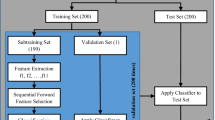Abstract
Respiratory sound (RS) signals carry significant information about the underlying functioning of the pulmonary system by the presence of adventitious sounds. Although many studies have addressed the problem of pathological RS classification, only a limited number of scientific works have focused in multi-scale analysis. This paper proposes a new signal classification scheme for various types of RS based on multi-scale principal component analysis as a signal enhancement and feature extraction method to capture major variability of Fourier power spectra of the signal. Since we classify RS signals in a high dimensional feature subspace, a new classification method, called empirical classification, is developed for further signal dimension reduction in the classification step and has been shown to be more robust and outperform other simple classifiers. An overall accuracy of 98.34 % for the classification of 689 real RS recording segments shows the promising performance of the presented method.





Similar content being viewed by others
References
Al-Naami B, Al-Nabulsi J, Amasha H, Torry J (2010) Utilizing wavelet transform and support vector machine for detection of the paradoxical splitting in the second heart sound. Med Biol Eng Comput 48:177-184
Aminghafari M, Cheze N, Poggi JM (2006) Multivariate de-noising using wavelets and principal component analysis. Comput Stat Data Anal 50:2381-2398
Bahoura M (2009) Pattern recognition methods applied to respiratory sounds classification into normal and wheeze classes. Comput Biol Med 39:824-843
Bahoura M, Pelletier C (2003) New parameters for respiratory sound classification. In: Proceedings of IEEE Conference Electrical Computer Engineering, vol 3, pp 1457–1460
Bakshi B (1998) Multiscale pca with application to mspc monitoring. AIChE J 44:1596–1610
Bakshi B (1999) Multiscale analysis and modeling using wavelets. J Chemometrics 13:34, 415–434
Chien JC, Wu HD, Chong FC, Li CI (2007) Wheeze detection using cepstral analysis in gaussian mixture models. In: Proceedings of 29th IEEE EMBS Conf, pp 3168–3171
Chitaliya NG, Trivedi AI (2010) Feature extraction using wavelet-pca and neural network for application of object classification and face recognition. In: Second International Conference on Computer Engineering and Applications (ICCEA), vol 1, pp 510–514
Folland R, Hines E, Boilot P, Morgan D (2002) Classifying coronary dysfunction using neural networks through cardiovascular auscultation. Med Biol Eng Comput 40:339–343
Forgacs P (1978) The functional basis of pulmonary sounds. Chest 73(3):399
Fredberg JJ, Holford SK (1983) Crackles: recording, analysis and clinical significance. J Acoust Soc Am 73:1036–1046
Homs-Corbera A, Fiz JA, Morera J, Jané R (2005) Time–frequency detection and analysis of wheezes during forced exhalation. IEEE Trans Biomed Eng 51(1):182–186
Jin F, Krishnan S, Sattar F (2011) Adventitious sounds identification and extraction using temporal-spectral dominance based features. IEEE Trans Biomed Eng (in press)
Kandaswamy A, Kumar CS, Ramanathan R, Jayaramana S, Malmurugan N (2004) Neural classification of lung sounds using wavelet coefficients. Comput Biol Med 34(6):523–537
Lehrer S (1993) Understanding lung sounds. Saunders, Philadelphia
Mazloom M, Kasaei S, Neissi HA (2009) Construction and application of svm model and waveletpca for face recognition. In: Second International Conference on Computer and Electrical Engineering, 2009. ICCEE ’09. vol 1, pp 391–398
Pearson K (1901) On lines and planes of closest fit to systems of points in space. Phil Mag 6(2):559–572
Percival DP, Walden AT (2000) Wavelet methods for time series analysis. Cambridge University Press, Cambridge
Piirilä P, Sovijärvi ARA (1995) Crackles: recording, analysis and clinical significance. Eur Respir J 8:2139–2148
Safari M, Harandi MT, Araabi BN (2004) A svm based method for face recognition using a wavelet pca representation of faces. In: International conference on image processing, 2004. ICIP’04, vol 2, pp 853–856
Sankur B, Kahya YP, Guler EC, Engin T (1994) Comparison of AR-based algorithms for respiratory sounds classification. Comput Biol Med 24(1):67–76
Sovijärvi ARA, Vanderschoot J, Eavis JR (2000) Standardization of computerized respiratory sound analysis. Eur Respir Rev 10(77):585–649
Taplidou SA, Hadjileontiadis LJ (2007) Wheeze detection based on time–frequency analysis of breath sounds. Comput Biol Med 37:1073–1083
Tilkian AG, Conover MB (2001) Understanding heart sounds and murmurs: with an introduction to lung sounds. Philadelphia
Vidakovic B (1999) Statistical modeling by wavelets. Wiley, New York
Wang W, Guo Z, Yang J, Zhang Y, Durand L, Loew M (2001) Analysis of the first heart sound using the matching pursuit method. Med Biol Eng Comput 39:644–648
Wilkins RL, Hodgkin JE, Lopez B (2004) Fundamentals of lung and heart sounds. Audio CD, Mosby
Xie S, Lio P, Lawniczak AT (2009) A comparative study of noise effect on wavelet based de-nosing methods. In: Proceedings of IEEE TIC-STH, pp 991–999
Acknowledgments
The authors acknowledge the financial support from MITACS and Ryerson University, under MITACS Elevate Strategic Post-doctoral Award. The contribution of Singapore National University Hospital, especially Dr. DYT Goh and Dr. I. M. Louis, is also gratefully acknowledged for their support in data collection and identification.
Author information
Authors and Affiliations
Corresponding author
Rights and permissions
About this article
Cite this article
Xie, S., Jin, F., Krishnan, S. et al. Signal feature extraction by multi-scale PCA and its application to respiratory sound classification. Med Biol Eng Comput 50, 759–768 (2012). https://doi.org/10.1007/s11517-012-0903-y
Received:
Accepted:
Published:
Issue Date:
DOI: https://doi.org/10.1007/s11517-012-0903-y




